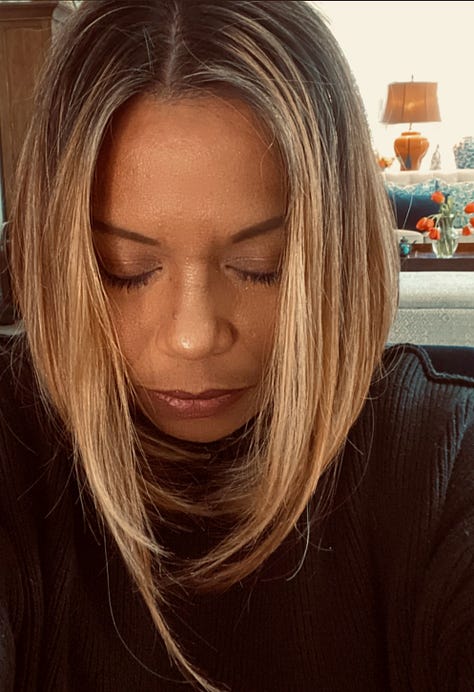06.13.25 Los Angeles, CA 8:12 a.m.
When I was a small child growing up, my siblings and I were not allowed to attend funerals. Somewhere within the Catholic religion- or perhaps more precisely, in the Catholicism filtered through cultural sensibilities and parental protection- the death of someone was not something young people needed to confront. The body was for the adults. The ritual of goodbye, the grief itself, was considered too heavy, too sacred, too complicated to be shouldered by children.
So instead, we stayed home and waited for the adults to return, dressed in black, smelling faintly of incense and lilies, their voices quieter than usual. They carried grief in their bodies the way one carries groceries- carefully, without letting anything spill.
No one explained what had happened, everyone would go into their rooms, no words- only that someone had “gone home.” It was as if we were expected to learn loss through implication.
Grief, we are told, is what happens when someone we love dies. It comes wrapped in black, it arrives with casseroles and condolence cards, and then, at some point, it is supposed to leave. Or at least recede.
But this version, the socially sanctioned narrative of grief, misses something quieter and, in many ways, more pervasive: the grief that accompanies the end of moments. The death not of people, but of small joys. The overlooked rituals that once formed the scaffolding of a life, are now hollowed out by time.
But there is also a kind of grief that doesn’t require a funeral, a burial, or a memorial. It creeps in when you walk into a room and forgets why it once made you feel safe. It shows up in the silence of a phone that no longer rings with a particular name. It lingers in the instinct to share something like a funny story, a small triumph- with someone who is no longer there, not because they’ve died, but because the connection has quietly withered, or the context and the conditions have changed beyond recognition. We rarely name this kind of loss. It doesn’t announce itself with elegies or rituals. But it is grief all the same.
This grief isn’t loud. It doesn’t ask for attention. Instead, it shuffles its feet in the soft corners of your day- where the light used to fall a certain way on the kitchen floor before you rearranged the furniture, or in the stillness of a morning when no one needs you the way they once did. It is a mother folding laundry for one, instead of three, or setting the table for one after years of automatic twos, actually fours. But no one has died. And yet something is gone.
We say time heals. And it does. But perhaps too well. The body forgets to ache. The mouth stops forming the name. You stop checking the old café’s hours. You stop imagining what it would feel like for your hand to be held like that again.
At first, this seems like progress- until you realize that grief has been doing its work not by restoring you, but by sanding down the edges of your memory. Not by carrying you through the storm, but by slowly draining your need for the sky that came before it. You’ve stopped hurting. But you’ve also stopped reaching. How strange. Really.
There’s a betrayal in this. A betrayal not of the person or moment that’s been lost, but of the version of yourself that once knew how to want it. That knew how to feel joy in the repetition. The Sunday morning phone call. The sound of a key in the door at 6:15. The leash hanging on the hook in the back.
These things die without headlines. They die without protest. And their absence breeds a kind of grief that is all the more potent for its subtlety.
And so, we mourn not just souls, but the patterns they formed around us. The touchstones of daily intimacy. The sentences that will never be finished. The parts of ourselves that we gave to someone or something- and will never get back in quite the same shape.
Then there is also that grief of not wanting some shapes back. It is a quieter grief. It is harder to confess. Because we are supposed to want what we’ve lost. We are supposed to yearn for our former selves- the eager one, the generous one, the one who stayed up late waiting for someone who never came. But sometimes healing means seeing that version of yourself clearly and choosing not to return to her. Sometimes the real mourning is for the time spent molding yourself into something you no longer recognize.
This is not bitterness. It’s not even regret. It is the outgrowing of skin you once wore like armor. The grief of knowing that, even if the past came knocking, you would not open the door- not out of anger, but because you’ve rearranged the interior and there is only room for what you need- but because the light falls differently now, and you have come to love this new geography, with all its blank spaces and unpromised corridors.
There are goodbyes we never say aloud, to the person we thought we’d be by now. To the friendships we kept feeding long after we were starving in them. To the dreams that softened, then stiffened, then slipped quietly out of reach.
And what remains is not sorrow exactly, but a kind of awe at our capacity to keep becoming. To grieve, not just what was, but what we no longer wish to return to.
Maybe grief isn’t a wound, but a seduction. A gentle teacher. A sculptor that shapes absence into something so smooth we forget it was ever sharp. The problem is not that we grieve. The problem is that, eventually, we stop. But why?







Great read! a different way to look at the concept of grief. Losing habits, people and places that I used to enjoy really helped me re-inteprete the concept. You are an amazing writer, Carmen.